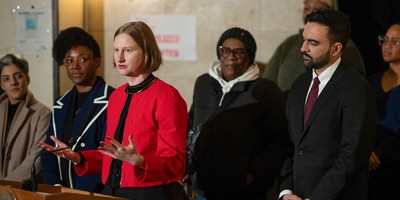Over 2,500 medical students and healthcare professionals at over 30 leading medical centers held events on Monday urging the public to treat "gun violence" as a public health crisis, The Mercury News reported.
The events were part of Scrubs Addressing the Firearms Epidemic (SAFE), a non-partisan action co-founded by Stanford’s Professor of Medicine Dr. Dean Winslow, a Republican, and fourth year medical student Sarabeth Spitzer, a Democrat. Winslow is a retired U.S. Air Force colonel and flight surgeon who was deployed six times to Iraq and Afghanistan.
At Stanford, healthcare professionals spoke about the health risk associated with guns, the gun epidemic and trauma care. At the University of California San Francisco, two panels discussed California's firearms laws and recommended ways to talk to patients about firearm access, safety, and risk.
According to Spain, it's difficult for medical professionals to get involved in the gun debate because of the political nature surrounding firearms.
“If this were any other public health problem, we wouldn’t stand for it. But it’s such a hot button political topic that we lose the ability to talk about it," Spain told The Mercury News. “We’ve been a little slow. We’re politically adverse. Our mission is education and research. This is advocacy.”
Medical associations and groups have become involved in the gun control debate. The American Academy of Pediatrics, the American College of Physicians and the American Medical Association are just a few who have thrown their hat into the arena.
Recommended

A Necessary Partnership?
In addition to their events, SAFE is partnering with AFFIRM research, a "non-profit corporation comprised of healthcare leaders and researchers who seek to end the epidemic of gun violence through research, innovation and evidence-based practice."
The partnership is designed to help bridge the gap in what's missing in medical and nursing school curriculums. According to Spitzer, medical professionals are taught how to talk to patients about diet, exercise, smoking, seat belts and various other topics but firearms aren't on the list.
“But there’s nothing in the curriculum about firearms,” Spitzer said. “How can we answer patients’ questions? This is critical for physicians to be able to reduce the injuries from firearms.”

Teaching a Class on Gunshot Wounds
If doctors held a class on gunshot wounds, Spain said they would reiterate the following points:
• Bullets don't travel in a straight line once they enter the body. If the tip of the bullet explodes "it rips everything up. It’s pretty devastating,” said Spain.
• If there's one bullet hole it's impossible for doctors to know if it traveled up, down or side-to-side.
• Doctors have to guess which way they believe the bullet traveled.
* Doctors are facing enormous odds when they try to save a patient suffering from a gunshot wound.
Most notably, the doctors want people to know that semi-automatic firearms should not be in the hands of the average civilian:
And: semi-automatic weapons have no role in contemporary civilian life. For Winslow, the wounds conjure up painful memories of when, working in a front line hospital in a war zone, he was called to the morgue to pronounce death on casualties — coalition soldiers or American civilians — brought in from the field. He looked for dog tags, examined the remains and signed preliminary death certificates. He recalled the surgeon’s note that accompanied the body of a young U.S. Army captain, shot in the neck: “It was an honor to care for this brave American soldier. May God rest his soul.”
Two days after the mass shooting at a church in Sutherland Springs, Texas on Nov. 5, 2017, Winslow opined that it was “insane … that in the United States of America a civilian can go out and buy a semiautomatic weapon like an AR-15.” Nominated by President Trump for the post of assistant secretary of defense for health affairs, Winslow fell out of contention.
It's interesting that someone who was in the Military would advocate for a ban on semi-automatic firearms. Winslow must be someone who doesn't know the difference between a semi-automatic gun and a fully automatic firearm.
Let's review, shall we?
Semi-automatic means one round is fired with each trigger pull. Fully automatic means you can pull the trigger, hold it down and it will continually fire off rounds.
The majority of guns you see are semi-automatic. And when I say majority, I mean 99 percent of all civilian firearms are semi-auto. Calling for a ban on semi-autos is essentially calling for a ban on all firearms.

























Join the conversation as a VIP Member